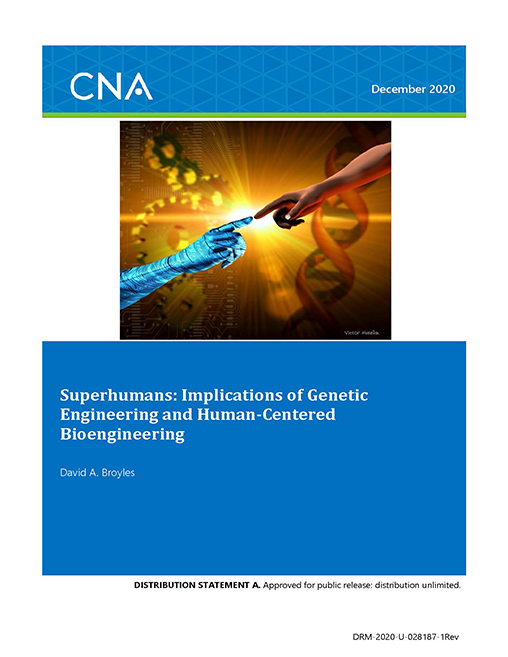Throughout history, humans have pursued ways to improve themselves and gain advantages, whether through information, technology, or physical enhancement. Although advancements in machine learning offer the promise of computers with “superhuman” capabilities, two other advancements will soon offer options that only science fiction has envisioned and explored. Biotechnology—specifically, the physical modification of biology with technology—has a trajectory that goes beyond reversible “human-machine teaming” and ends with cyborg-like possibilities of endless enhancements and modifications. And genetic engineering, particularly with the accessibility offered by CRISPR1 (clustered regularly interspaced short palindromic repeats) and related technologies, has a trajectory that promises smarter, stronger, and “better” humans from birth, heralding the advent of “homo superior.”
Although the US military has made advances in exploring the applications of human engineering with robotics and human-machine teaming, the applications of genetic modifications and biotechnology to human physiology have received less attention. Meanwhile, genetic engineering and human-centered bioengineering are already seeing effects in society. This paper examines the trajectory of advancements in these areas, and it derives relevant issues and considerations for the military.
To put these latest technologies into perspective, we examined the history of human modification and observed that humans have been extensively modifying themselves for a long time, and they will continue to do so. The latest human modifications focus on the human “hardware”: the neural, somatic, and germline, as well as things fused with the body; these human modifications are different from those that have come before. And various newly formed groups want to choose deliberately the path that humanity takes as it explores these modifications.
We examined the trends in research of genetic engineering and “human-centered bioengineering” (our term for cyborgs that also encompasses a few more technological options). Advances in the nuclease2 family of gene editing tools, of which TALENs (transcription activator-like effector nucleases) and CRISPR-associated (CRISPR-Cas) are the latest members, have enabled ever more precise and flexible options for researchers. And advances in prosthetics (including sensory and organ parts), brain-machine interfaces, and wearables (including exoskeletons) continue to make smaller, lighter, cheaper, and more “restorative” technologies possible. In the near term, we expect the trends for these research areas to continue focusing on correcting human diseases and injuries. As researchers work through nontrivial safety issues, expanding options and availability will transform the lives of those who need them. In the longer term, these research areas have the potential to expand from corrective applications to enhancement applications; both research areas stand at this threshold, with human-centered bioengineering perhaps a bit further ahead. While the United States, China, and Russia continue to invest heavily in these research areas, the biohacker community plays an important role. With the connectivity of the internet, the sharing of information and procedures, the providing of equipment and alternatives, and a passion to explore and experiment (sometimes on themselves), biohackers are helping to push the envelope of research.
Download reportDISTRIBUTION STATEMENT A. Approved for public release: distribution unlimited.
This work was performed under Federal Government Contract No. N00014-16-D-5003.
Details
- Pages: 82
- Document Number: DRM-2020-U-028187-1Rev
- Publication Date: 12/1/2021
